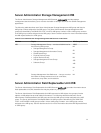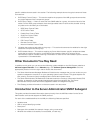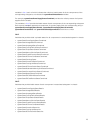
NOTE: As of iDRAC7 firmware release r1.30.30, iDRAC7 supports SNMP query operations (GET,
GETNEXT, GETBULK) via the SNMPv3 protocol, in addition to supporting query operations via the
SNMP v1 and SNMP v2c protocols. More specifically, iDRAC7 now supports the SNMP User Security
Model (USM).
SNMP Traps
SNMP is frequently used to monitor systems for fault conditions such as temperature violations, hard
drive failures, and so on. Management applications can monitor for these conditions by polling the
appropriate OIDs with the Get command and analyzing the returned data. This method has its drawbacks.
If it is done frequently, significant amounts of network bandwidth can be consumed. If it is done
infrequently, the response to the fault condition may not occur in a timely fashion. SNMP traps avoid
these limitations of the polling method.
An SNMP trap is an asynchronous event indicating that something significant has occurred. This is
analogous to a pager receiving an important message, except that the SNMP trap frequently contains all
the information needed to diagnose a fault.
Two drawbacks to SNMP traps are that they are sent using UDP, which is not a guaranteed delivery
mechanism, and that they are not acknowledged by the receiver.
An SNMP trap message contains the trap’s enterprise OID, the agent IP address, a generic trap ID, the
specific trap ID, a time stamp, and zero or more variable bindings (varbinds). The combination of an
enterprise OID and a specific trap ID uniquely identifies each Server Administrator-defined trap. A varbind
consists of an OID and its value and provides additional information about the trap.
In order for a management system to receive SNMP traps from a managed system, the node must be
configured to send traps to the management system. Trap destination configuration is dependent on the
operating system. When this configuration is done, a management application on the management
system can wait for traps and act on them when received.
For a list of traps supported by the Server Administrator Instrumentation Service, see Instrumentation
Traps. For information on Server Administrator Storage Management traps, see Storage Management
Alert Reference.
18


















